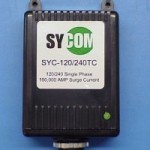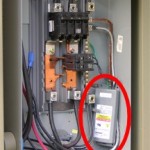Do you know what “whole house surge protectors” are?
H.D. Biddle was jolted with the knowledge that he could have spent $200 and prevented the loss of thousands of dollars.
Now he knows about them.
One night in late November, Biddle remembers, the lights in his home flickered and the television set turned off. The power went off and came back on.
The next morning, the toaster didn’t work. The family found that the dishwasher and garbage disposal stopped working, too. The digital video recorder for the TV failed. The furnace was quiet.
He realized that his house might have been hit with a power surge, a voltage spike that can be caused by a number of factors.
Most common causes: downed power lines, a lightning strike, household appliances cycling on and off, or a sudden change in electricity usage at a nearby factory.
Biddle hired an electrician who couldn’t find any wiring problems in the house. The electrician wrote that the problems were caused by “a power company line surge on one phase, thereby causing the failure of said electrical appliances and heat units.”
He contacted Oncor, which owns and services the power lines in parts of North Texas, where Biddle lives, and asked it to help pay for the loss. Oncor sent a service rep to look things over. The rep said he found nothing wrong.
Then in December, a letter from Oncor informed Biddle that the company had denied his claim. Oncor told him that it had no responsibility for electricity spikes and that it was up to the homeowner to protect his or her home.
Biddle had lost about $7,000 in electrical appliances and expenses from the mishap. His family went without heat until the furnace was repaired. Everything else had to be replaced.
Biddle wrote to Watchdog Dave Lieber at the Fort Worth Star-Telegram for help. And after that, Oncor offered to send another service rep over to install a recording voltmeter on the lines to the house to see what the levels were. But Biddle declined, saying the surge was a one-time deal and wouldn’t show up on a test.
“The customer is responsible for installing grounding and other protective devices to protect their equipment,” Oncor spokesman Carol Peters says. “Unless Oncor has some prior knowledge of a problem and unless we did something wrong causing the problem, we do not pay on these kinds of damages,” she adds. “The cause is unknown and undetermined.”
Biddle’s insurance company covered about 30 percent of his loss. The family’s out-of-pocket costs came to more than $4,000. Frustrated, Biddle says, “Oncor dismissed the matter and attempted to ignore us altogether.”
So what’s the solution?
Everyone knows about small surge protectors that became popular when personal computers and printers entered homes in the 1980s. You attach them to your electronics, and when a spike occurs, the surge protector gives its life to save the appliance.
In Biddle’s house, his music system was protected by a small surge protector and survived the ordeal just fine.
But in the last several years a new product has entered the residential market called a whole-house surge protector.
Installed on the main line leading into the house, it is designed to protect appliances as well as phone and cable lines from voltage spikes.
A few years ago, these cost about $350 and had to be installed by a qualified electrician. Recently, some area electricians are offering the product and installation for about half of that. So shop around.
I had one installed last year and still use the smaller protectors on computer equipment for backup.
Biddle has a new whole-house surge protector, too.
Some U.S. power companies offer whole-house surge protection to their customers. Oncor does not.
“I’m not familiar with a whole-house surge protector, and we wouldn’t endorse a particular product,” said Peters, the Oncor spokeswoman. “From our side, we’re doing what we’re supposed to do. Deliver electrical service on a reliable basis.”
Biddle wishes that Oncor informed customers more clearly before a surge, rather than after, that surge protection is their responsibility. As Oncor wrote to Biddle, “If protection on customers’ equipment is desired, the customer must select, install and maintain the protective equipment.”
Now you know.
And thanks to Ralph Weibaum who provided me with this very informative website on surges.
# # #
Dave Lieber, The Watchdog columnist for The Fort Worth Star-Telegram, is the founder of Watchdog Nation. The new 2010 edition of his book, Dave Lieber’s Watchdog Nation: Bite Back When Businesses and Scammers Do You Wrong, is out. Revised and expanded, the book won two national book awards in 2009 for social change. Twitter @DaveLieber


![IMG_1030[1] This surge protector at Watchdog Nation fried over the weekend, a reminder of the Belkin surge protector recalls.](http://watchdognation.com/wp-content/uploads/2010/01/IMG_10301-1024x768.jpg)


